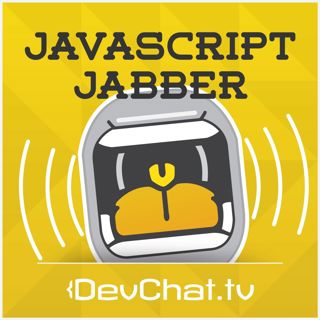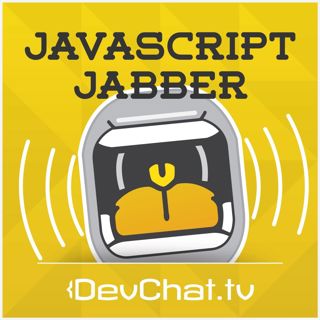
Vibe Coding: Building Faster with AI-Powered Development - JSJ 687
In this episode of JavaScript Jabber, we dive deep into the world of vibe coding—what it means, how it works in practice, and why it’s changing the way developers build software. I’m joined by Anthony Campolo, who shares his hands-on experience developing AutoShow, an app that automates podcast show notes, using AI-assisted workflows. We talk about how tools like Claude, ChatGPT, and Gemini accelerate development, the role of rule files, and the balance between automation and manual QA.Along the way, we explore the impact of LLMs on junior vs. senior developers, how companies are adapting AI-driven coding practices, and whether the future of software development still requires humans in the loop. This conversation blends real-world coding insights, practical tools, and some big-picture questions about where AI is taking the industry.Check out Anthony Campolo here.Become a supporter of this podcast: https://www.spreaker.com/podcast/javascript-jabber--6102064/support.
22 Elo 1h 11min

The Next Wave of Dev Tools: AI Assistants and JavaScript Workflows - JSJ 686
In this episode of JavaScript Jabber, we sit down with Vinicius Dallacqua, a seasoned software engineer with a passion for performance and developer tooling. Vinicius shares his journey from coding in central Brazil with limited connectivity to building cutting-edge tools like PerfLab and PerfAgent. We dive into the intersection of AI and DevTools, exploring how artificial intelligence is transforming performance debugging, web development workflows, and even the future of browsers.We also tackle the big questions: How do developers avoid bias when building in high-performance environments? What role will agentic browsers play in the evolution of the web? And how can AI-powered DevTools lower the barrier for developers intimidated by performance profiling? If you’re curious about the future of frontend performance, DevTools, and AI-driven development, this conversation is packed with insights.Links & ResourcesPerfLab – Performance tooling platformPerfAgent – AI-powered DevTools assistantVinicius Dallacqua on X (Twitter)Paul Kinlan’s AI Focus – Essays on AI and the webPerfNow Conference – Leading performance conference in AmsterdamBecome a supporter of this podcast: https://www.spreaker.com/podcast/javascript-jabber--6102064/support.
14 Elo 1h 6min

Inside VueConf: Nuxt 4, AI in Development, and the Future of Vue with Erik Hanchett - JSJ 685
In this episode of JavaScript Jabber, we welcome back Erik Hanchett, Senior Developer Advocate at AWS, to dive into his experience at VueConf. From the energy of the Vue community to lightning talks on AI and Nuxt updates, Erik shares his insights on where Vue is heading and why in-person conferences are still so valuable for developers. We also explore the balance between “vibe coding” and spec-driven development, plus Erik introduces us to Amazon Q CLI and its powerful MCP integrations for smarter AI-assisted coding.Along the way, we discuss the evolving state of Vue, the rise of Nuxt 4, Evan You’s projects (including Vite and RollDown), and how Amplify is simplifying full-stack app development on AWS. Whether you’re a Vue developer, curious about AI in frontend workflows, or just want to catch up on what’s happening in the broader JavaScript ecosystem, this episode is packed with insights you won’t want to miss.🔗 Links & ResourcesAmazon Q Developer CLI on GitHubAWS Amplify DocumentationCommit Your Code ConferenceErik Hanchett on X (Twitter)Program With Erik YouTube ChannelBecome a supporter of this podcast: https://www.spreaker.com/podcast/javascript-jabber--6102064/support.
8 Elo 58min

Running Doom in TypeScript’s Type System with Dimitri Mitropoulos - JSJ 684
What if I told you someone managed to run Doom inside TypeScript’s type system? Sounds insane, right? That’s exactly what our guest Dimitri Mitropoulos did—and in this episode, we dive deep into the how, the why, and the mind-bending implications of this ambitious project. From type-level programming to the philosophical limits of Turing completeness, this is an episode that pushes the boundaries of what you thought was possible in JavaScript.We talk about how the TypeScript type system evolved to become Turing-complete, how Dimitri pulled off this seemingly impossible feat, and why “Doom-complete” might just be the new gold standard for computational capability. Along the way, we touch on functional programming, generics, recursion, and even some Lambda Calculus. It’s part computer science theory, part coding madness, and 100% geeky goodness.Episode Highlights[3:05] – Dimitri explains how a simple thought experiment turned into a year-and-a-half-long obsession[8:40] – The origins and significance of Turing completeness in type systems[14:15] – Why running Doom in TypeScript is more about proving limits than just showing off[19:55] – What it means to run programs inside the type system vs. TypeScript code itself[27:10] – ASCII art as output, functional recursion for game state, and hover-over frames in your editor[35:30] – How ignorance, determination, and obsession fueled the completion of the project[45:20] – Personal insights: balancing family, burnout, and passion while chasing an impossible dreamLinks & ResourcesDimitri MitropoulosMichigan TypeScript YouTube Channel – Dimitri's channel featuring the projectType Challenges by Anthony Fu – Advanced TypeScript exercisesSquiggleConf – The TypeScript-focused conference Dimitri co-foundedJosh Goldberg – TypeScript expert and co-organizer of SquiggleConfBecome a supporter of this podcast: https://www.spreaker.com/podcast/javascript-jabber--6102064/support.
1 Elo 1h 18min

Preact, Performance, and the Future of Lightweight Frontends with Ryan Christian -JSJ 683
In this episode of JavaScript Jabber, we sit down with Ryan Christian, a core maintainer of Preact, to talk all things lightweight, performant, and practical in the JavaScript world. If you’ve ever wondered what makes Preact tick, why it continues to gain traction, and how it compares to the heavyweight champ React—this episode is for you.We get into the nitty-gritty of what separates Preact from React, not just in size but in philosophy. Ryan sheds light on how Preact is engineered for performance, why it's not just a “React clone,” and how its compatibility layer makes it easy to drop into existing projects. Plus, we explore signals, class components, and what the upcoming Preact v11 has in store.Episode Highlights[1:23] - Meet Ryan Christian: Preact core maintainer and open-source champion[4:10] - What is Preact, and how does it stack up against React?[10:15] - Preact’s tiny footprint and why size still matters[14:47] - Widgets, adoption, and why Preact powers ~6% of major sites[20:01] - Understanding Preact’s compatibility layer (PreactCompat)[25:40] - Hooks, signals, and modularity: build what you need, nothing more[31:10] - Why Preact won’t follow React into full-stack territory[37:22] - Server components, suspense, and what Ryan recommends instead[43:35] - Frameworks that pair well with Preact: Astro, Fresh, and Remix[47:55] - Sneak peek at Preact v11 and why it sticks with “classic” React experience🔗 Links & ResourcesPreact Official WebsiteAstroFresh by DenoRemixJason Miller’s VTalk on Signals (referenced)Google CrUX Report – for framework usage statsBecome a supporter of this podcast: https://www.spreaker.com/podcast/javascript-jabber--6102064/support.
23 Heinä 1h 7min

Speaking Up: The Developer’s Guide to Conference Talks & Career Growth - JSJ 682
In this episode of JavaScript Jabber, I am joined by three incredible guests — Ariel Shulman, Liad Yosef, and Evyatar Alush — to dive into the world of public speaking in tech. From the jitters of their first talk to the professional and personal growth that comes with hitting the stage, we unpack the full journey of becoming a tech speaker. Whether you're just curious about getting started or want to sharpen your presentation game, this episode is packed with real talk and insights from experienced voices in the community.We get personal about the why, the how, and the what next of conference speaking — covering the motivations, the process of getting accepted, tips for preparing standout talks, and even how public speaking can open doors to career-changing opportunities. If you've ever wondered what it really takes to be heard on stage, this conversation might just be your launchpad.🔗 Links & ResourcesReact Next ConferenceNo TLB ConferenceJS Heroes RomaniaSessionize - CFP platformReversim Tech ConferenceReact SummitGitNation ConferencesBecome a supporter of this podcast: https://www.spreaker.com/podcast/javascript-jabber--6102064/support.
10 Heinä 1h 44min

How Holepunch Is Redefining Peer-to-Peer Apps with Bare.js — A New Era for JavaScript Developers -JSJ 681
In this episode, we sit down with Mathias Madsen, CEO of Holepunch, and take a wild ride through the cutting edge of peer-to-peer JavaScript development. Mathias shares his journey from accidentally discovering JavaScript in college to becoming a prolific contributor with over 1,500 open source modules. His passion? Building decentralized, peer-to-peer systems where JavaScript isn’t just for the browser—it powers the entire stack.We dive deep into how Holepunch is reimagining application distribution with their Pear system —essentially turning peer-to-peer into a first-class citizen for distributing full applications, not just files. No hosting, no servers — just apps shared directly, BitTorrent-style. And because packaging and distributing Node-based apps can be painfully complex, they took things a step further by building a new runtime: Bare.jsBare.js is refreshingly "bare": it strips away the heavy, opinionated APIs bundled into Node or Deno, leaving just the JavaScript core and a powerful module system. What’s revolutionary here is Bare's ability to run the same codebase across desktop, mobile, and even tiny embedded devices—swapping out engines like V8, JavaScriptCore, or JerryScript depending on the platform's needs. This allows Mathias' team to write backend logic once, share it across all platforms, and iterate at lightning speed.Key takeaways:-Peer-to-peer can go far beyond media sharing — it's being used for full app distribution.-Bare.js decouples JavaScript from specific platforms, creating a universal backend that just works anywhere.-Modular design isn't just a philosophy — it's the secret to Holepunch’s rapid development pace.-The combination of React Native for UI and Bare.js for backend creates an insanely productive development pipeline, fully cross-platform.If you’re into JavaScript, peer-to-peer tech, or just love hearing about developers breaking the mold, this one’s for you.About the GuestMathias is the CEO of Holepunch (https://holepunch.to/). He brings his passion for open-source software, and deep experience in the area, having published more than 1000 modules to npm, the Node.js package manager, totaling billions of downloads every month.Mathias Buus is a self taught Javascript hacker from Copenhagen. He works full time on open source projects and has been working with Node.js since the 0.2 days. Mathias likes to work with P2P and distributed systems and is the author of more than 550 modules on npm, including some of the most popular ones for working with streams. In addition he has spoken about mad science projects at various conferences around the world.Become a supporter of this podcast: https://www.spreaker.com/podcast/javascript-jabber--6102064/support.
24 Kesä 1h 6min

Migrating a Legacy JavaScript Codebase to TypeScript - JSJ 680
In this episode, Dan and I (Steve) dove deep into what turned out to be a surprisingly complex, yet incredibly insightful topic: gradually migrating a massive legacy JavaScript project over to TypeScript. We're talking about nearly 1,000 JS files, 70,000+ lines of code, and years of developer history—all transitioning carefully to a typed, modern future.Dan walked us through how he started by setting up the project for success before converting even one file—getting CI/CD ready, setting up tsconfig.json, sorting out test dependencies, dealing with mock leaks, and even grappling with quirks between VS Code and WebStorm debugging.We talked tools (like TS-ESLint, concurrently, and ts-node), why strict typing actually uncovered real bugs (and made the code better!), and why it’s crucial not to touch any .js files until your TypeScript setup is rock solid.Key Takeaways:Gradual migration is 100% possible—and often better—than ripping the bandaid off.TypeScript can and will catch bugs hiding in your JavaScript. Be prepared!Use VS Code extensions or TS-Node to support your devs’ tooling preferences.Don't underestimate the setup phase—it’s the foundation of long-term success.Start small: Dan's team converted just one file at first to test the whole pipeline.If you’re sitting on a legacy JS project and dreaming of TypeScript, this episode is your blueprint—and your warning sign.Become a supporter of this podcast: https://www.spreaker.com/podcast/javascript-jabber--6102064/support.
5 Kesä 1h 25min






















